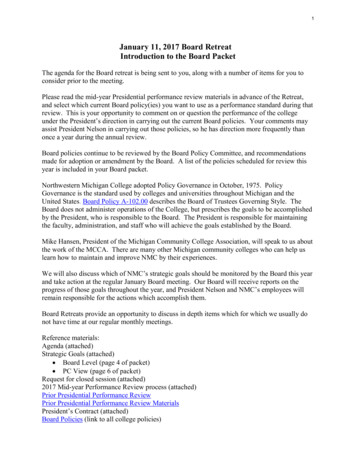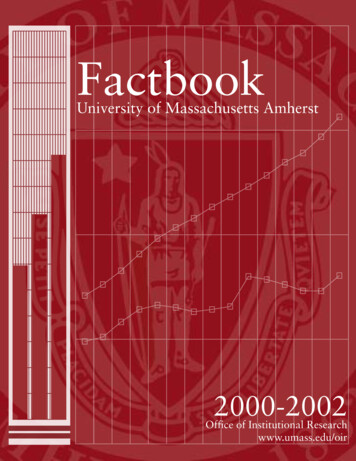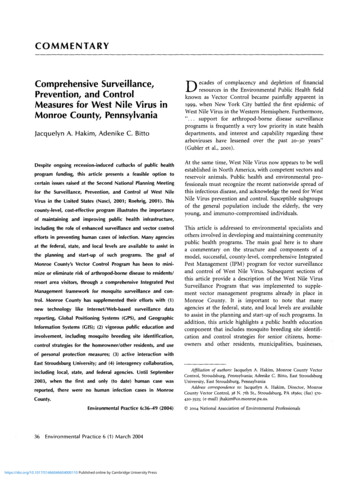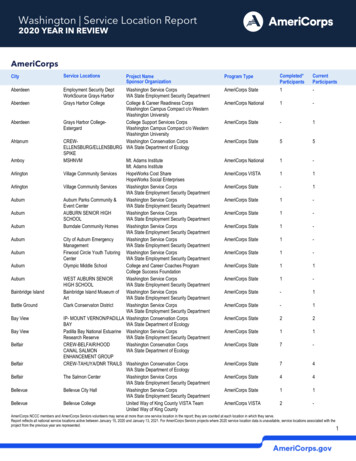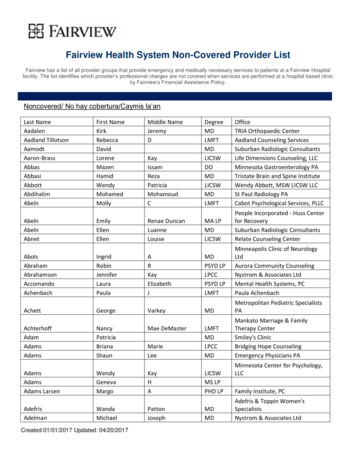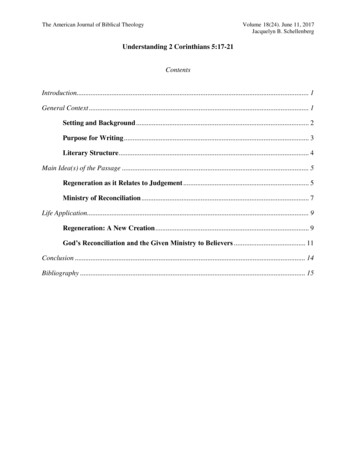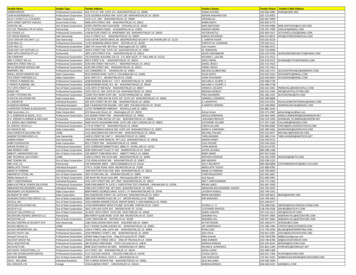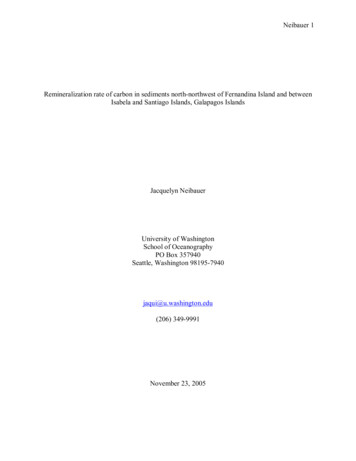
Transcription
Neibauer 1Remineralization rate of carbon in sediments north-northwest of Fernandina Island and betweenIsabela and Santiago Islands, Galapagos IslandsJacquelyn NeibauerUniversity of WashingtonSchool of OceanographyPO Box 357940Seattle, Washington 98195-7940jaqui@u.washington.edu(206) 349-9991November 23, 2005
Neibauer 2Project SummaryThe remineralization rate of carbon in ocean sediments found in the vicinity of theGalapagos Islands will be analyzed and an effort to relate it to the concentration of chlorophyll ain the overlying water column will be made. CTD fluorometer readings and sediment sampleswill be collected from the R/V Thomas G. Thompson at four sites north of Fernandina Island(expected high levels of chlorophyll a) and three sites in the canyon between Isabela andSantiago Islands (expected low levels of chlorophyll a), and a dissolved oxygen profile for eachsample will be obtained using an oxygen microelectrode. Oxygen penetration depths will beconverted to amount of carbon remineralization using the Redfield Ratio in an attempt toquantify the flux of carbon from ocean’s surface to the seafloor, ultimately resulting inpredictions about the movement of CO2 between the earth’s atmosphere and the deep ocean.IntroductionQuantifying the flux of carbon from the ocean’s surface to the sea floor is necessary topredict future levels of atmospheric carbon dioxide (Jahnke et al. 1990). Since the last glacialperiod, atmospheric CO2 has increased 85ppm, which is thought to be largely due to themovement of CO2 between the deep ocean and the atmosphere (Devol and Hartnett 2001). Theextent to which CO2 is absorbed from the atmosphere and subsequently transferred and stored inthe ocean is dependent upon (1) photosynthetic carbon fixation in the euphotic zone, (2) transferof some fraction of this fixed carbon out of the euphotic zone as export production, and (3)permanent carbon burial in marine sediments (Devol and Hartnett 2001). Carbon that isremineralized has the potential to be released back into the atmosphere, while carbon that isstored will not affect atmospheric carbon levels.
Neibauer 3Continental margins offer one of the largest sinks of carbon, with more than 90% of allorganic carbon burial presently occurring in continental margin sediments, due to the relativelylarge input of fresher organic matter when compared to deep-sea sediments (Hedges and Keil1995; Hartnett and Devol 2003). Organic matter delivered and incorporated into marinesediments is mineralized via multiple microbial pathways in which the oxidation of organiccarbon is carried out through the reduction of O2, NO3, oxides of Mn and Fe, and SO4(Thamdrup and Canfield 1996). It has been suggested that oxygen consumption is mostimportant in deep-sea sediments, and that the importance of NO3 and SO4 oxides as electronacceptors increases in continental slope and shelf sediments (Murray and Kuivila 1990).Furthermore, Hartnett and Devol (2003) found that in sediments on continental margins at depthsgreater than 1000m, the largest component of the total carbon oxidation rate was also oxygen.The Galapagos Islands is one area of the world that exhibits levels of productivity that arehigher than average (Torres 2002). Historically, high productivity and high chlorophyll aconcentrations are exhibited on the western side of Isabela Island, where the EquatorialUndercurrent brings nutrient-rich water to the surface (Feldman 1986; Martin et al. 1994). Areasthat exhibit large amounts of organic matter in the surface waters can potentially result in thetransport of a larger amount of organic matter to the seafloor, when compared to areas of lowsurface organic matter. However, it is important to note that other factors contribute to thedistribution of surface-originating organic matter among marine sediments, such as the depth ofthe water column. As organic matter sinks through the water column, a majority of it isbiologically oxidized, resulting in a decreasing carbon rain rate with depth and only a smallportion being available for burial in the sediments. Murray and Kuivila (1990) observed adecrease in organic carbon in sediments with increasing distance from the continental margin,
Neibauer 4which can be related to depth, in that depth generally increases as distance from the shelfincreases. It has been suggested that this relationship determines the quantity and time scale atwhich carbon is sequestered in the deep ocean (i.e. shallower regeneration depths will result inshorter sequestration times) (Devol and Hartnett 2001). Cai and Sayles (1996) compared oxygenpenetration in marine sediments and found that a site at which additional organic material, in theform of sewage, was disposed exhibited a much shallower oxygen penetration depth than thoseexhibited at uncontaminated sites. These data suggest that areas with higher organic matterdeposition will exhibit shallower oxygen penetration through the sediments and therefore highercarbon remineralization rates when compared to areas with lower organic matter deposition.With this study, I intend to address two main questions, (1) do sediment oxygen profilesand carbon remineralization rates vary among stations, and (2) is there a correlation betweenthese variations and concentrations of chlorophyll a in the overlying water column. Based on theresults and observations of previous studies, as discussed above, I expect areas that are relativelyhigh in surface chlorophyll a to exhibit shallower oxygen penetration depths, relatively highlevels of organic carbon in the sediments and faster carbon remineralization rates, whencompared to areas that are low in surface chlorophyll a concentration. Since the distribution oforganic matter in marine sediments is not entirely dependent on the amount of chlorophyll a inthe water column directly above it, a relationship among only high chlorophyll a concentrationstations will likely not be recognizable. However, I expect there to be some sort of discrepancybetween the relationships found at high versus low chlorophyll a concentration areas.Proposed ResearchIn order to determine sedimentary carbon remineralization rates, and attempt to comparethem among high and low chlorophyll a concentration regions of the Galapagos Islands,
Neibauer 5observations will be made from 20-28 January 2006 aboard the R/V Thomas G. Thompson usingthe shipboard Conductivity-Temperature-Depth (CTD) profiler, and sediment samples will becollected using a Spade box core. Samples will be collected at seven stations (Table 1, Fig. 1).Sediment locations for stations 1-4 were determined using seafloor maps generated from EM120data (Kurz et al. 2001) and all sample stations were chosen based on the expected availability ofsediment and expected surface chlorophyll a concentrations (Martin et al. 1994). Theavailability of sediment at stations 5-7 is assumed, based on the observation that the region ischaracterized by a canyon and it is likely that sediments accumulate in it. However, upon arrivalat each station, the 3.5 kHz sub-bottom profiler will be utilized to confirm the existence ofsediments.CTD casts will penetrate 500m through the water column. One sediment sample will betaken at each station and will immediately be gently sub-sampled with PVC core liner tubes (3inch diameter, 7-inch length). Four replicate sub-samples from each box core will be taken inorder to obtain an average carbon remineralization rate for sediments at each station. Thecondition of the sediment-water interface will be noted. A well-preserved interface will bedefined as having clear overlying water and intact biological structures (Murray and Kuivila1990). For the purpose of this proposal, it is assumed that the sediment-water interface of allsamples will be preserved. It is important for the interface to remain undisturbed in order toobtain an accurate oxygen-depth profile. If the interface is not maintained, the resulting oxygenprofile will provide a maximum range of oxygen concentrations through the sediment, ratherthan an absolute range. Certain cases in which the sediment-water interface is not preservedusing the Spade box core include the over-penetration of the core into extremely soft sediments,in which case the speed of the corer as it penetrates the sediment should be reduced, and the
Neibauer 6occurrence of significant amounts of biogenic gases in the sediment, in which case not much canbe done to obtain an intact interface due to the effervescing of the gases as the core is brought tothe surface.A polarographic oxygen-needle microelectrode (Fig. 2) will be used to determine thedissolved oxygen profile for sediment samples (Revsbech et al. 1980). Profiles for all sedimentsamples will be recorded immediately upon retrieval to minimize the effects of transporting thecore out of its natural environment, including changes in salinity and atmospheric oxygensupply. A Ag/AgCl electrode will be used as a reference during measurements and an electricpotential between the silver reference electrode and the a glass-insulated platinum electrode willbe produced via a small black box connected to the electrodes. The electrodes will have beencalibrated prior to this experiment using air-saturated seawater (20% O2) and nitrogen-purgedseawater (0% O2). In order for the two electrodes to come into electrical equilibrium, oxygenwill be reduced at the platinum cathode and silver will be oxidized at the reference anode. Thismovement of electrons will produce a current which will be measured with a microvolt ammeter.The microelectrode will be inserted into the core from above with the assistance of amicromanipulator attached to a ring stand. An average current reading will be obtained from theoverlying water, which should closely represent the actual oxygen concentration in the water atthe seafloor. After defining the average water oxygen concentration, the microelectrode willcarefully be lowered to the point where the tip of the microelectrode just touches the sedimentsurface. A significant deflection in the electrode current should occur at this point, and will beused to confirm that the electrode is in fact at the surface of the sediment. The electrode will belowered into the core at 0.25mm increments and volt ammeter readings will be recorded at eachinterval. Probing will continue until the current reading reaches zero or remains constant for four
Neibauer 70.25mm intervals. This value will be called “zero” and will be used to convert obtained currentreadings to oxygen concentrations by the equation (Nuwer, J. pers. comm.):(current reading) – (“zero”)(water [O2]) – (“zero”)x307.4 [O2] µmol/kgThe computer program, Basic Profile, will be used to convert oxygen depth profiles to totaloxygen consumption in the sediments. Carbon remineralization rates will then be calculated viathe Redfield Ratio.
Neibauer 8Proposal BudgetEffectiveCostItemUnit CostQuantitySupplierCostR/V T.G. Thompson 18,000 /day2 daysUW OceanographyClass Budget 36,000.00 0.003.5 kHz sub-bottomprofilerincluded2 daysThompsonEquipment 0.00 0.00CTDincluded2 daysThompsonEquipment 0.00 0.00Spade box core 45 / day2 daysPooled Equipment 90.00 90.00Core liner (3-inch) 4 / ft1- 10 ftsectionPooled Equipment 40.00 40.00Core caps (3-inch) 0.25 / each18Pooled Equipment 4.50 4.50Polarographic oxygenneedle microelectrodeDonated2Keil Lab 0.00 0.00Ag/AgCl referenceelectrodeDonated2Keil Lab 0.00 0.00Microvolt ammeterDonated1Keil Lab 0.00 0.00MicromanipulatorDonated1Keil Lab 0.00 0.00Ring standDonated1Keil Lab 0.00 0.00 36,134.50 134.50
Neibauer 9ReferencesCai, W.J. and F.L. Sayles. 1996. Oxygen penetration depths and fluxes in marine sediments.Mar. Chem. 52: 123-131.Devol, A.H. and H.E. Hartnett. 2001. Role of the oxygen-deficient zone in transfer of organiccarbon to the deep ocean. Limnol. Oceanogr. 46: 1684-1690.Feldman, G. C. 1986. Patterns of phytoplankton production around the Galapagos Islands, p. 77106. In M. J. Bowman, C. M. Yentsch and W. T. Peterson [eds.], Tidal mixing andplankton dynamics. Springer-Verlag.Hartnett, H.E. and A.H. Devol. 2003. Role of a strong oxygen-deficient zone in the preservationand degradation of organic matter: A carbon budget for the continental margins ofnorthwest Mexico and Washington State. Geochim. Cosmochim. Acta. 67: 247-264.Hedges, J.I. and R.G. Keil. 1995. Sedimentary organic matter preservation: An assessment andspeculative synthesis. Mar. Chem. 49: 81-115.Jahnke, R.A., C.E. Reimers, and D.B. Craven. 1990. Intensification of recycling of organicmatter at the sea floor near ocean margins. Nature. 348: 50-54.Kurz, M., D. Fornari, and D. Geist. Cruise report : DRIFT Leg-4. August 23, 2001.Martin, J.H. and 43 others. 1994. Testing of the iron hypothesis in ecosystems of the equatorialPacific Ocean. Nature. 371: 123-129.Murray, J.W. and K.M. Kuivila. 1990. Organic matter diagenesis in the northeast Pacific:Transition from aerobic red clay to suboxic hemipelagic sediments. Deep-Sea Res. 37:59-80.Revsbech, N.P., J. Sorensen, and T.H. Blackburn. 1980. Distribution of oxygen in marinesediments measured with microelectrodes. Limnol. Oceanogr. 25: 403-411.
Neibauer 10Thamdrup, B. and D.E. Canfield. 1996. Pathways of carbon oxidation in continental marginsediments of central Chile. Limnol. Oceanogr. 41: 1629-1650.Torres, Ch.G. 2002. Distribution of chlorophyll 'a' in the equatorial Pacific Ocean (82 W-92 W),during 1988-1999 (Ecuador) (poster). In M. Brown et al. [eds]. The colour of ocean data:International symposium on oceanographic data and information management, withspecial attention to biological data. Brussels, Belgium, 25-27 November 2002: book ofabstracts. VLIZ Special Publication. 11: 88.
Neibauer 11TablesTable 1. Station locations and depths for 20-28 January 2006 ated Depth(m)10 9.2'91 53.3'325020 5.7'91 50.5'310030 9.7'91 42.1'245040 13.6'91 36.4'245050 13.0'91 1.3'230060 16.0'91 1.0'200070 17.0'91 0.5'1800
Neibauer 12Figure LegendsFigure 1. Map of the Galapagos Islands with stations to be visited for 20-28 January 2006research. Negative signs indicate western longitudes and southern latitudes. Map adapted fromKurz et al. (2001).Figure 2. Diagram of the polarographic oxygen needle-microelectrode that will be used to obtainoxygen profiles for sediment samples.
Neibauer 13FiguresFigure 1.
Neibauer 14Figure 2.
Neibauer 1 Remineralization rate of carbon in sediments north-northwest of Fernandina Island and between Isabela and Santiago Islands, Galapagos Islands Jacquelyn Neibauer University of Washington School of Oceanography PO Box 357940 Seattle, Washington 98195-7940 jaqui@u.washington.edu (206) 349-9991 November 23, 2005
